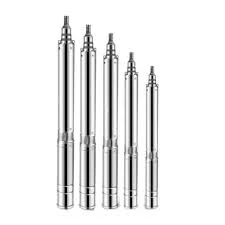ಫೆಬ್ರ . 16, 2025 02:31 Back to list
135QJ Deep Well Submersible Pump
Installing a Submersible Pump Expert Insights for Optimal Performance
The physical installation demands meticulous attention. Proper alignment of the pump and its components is essential to minimize vibrations and wear. Submersible pumps should be suspended with robust, non-corrosive cables or pipes, designed to withstand both the weight of the pump and the forces exerted by the flowing water. Additionally, the installation should include a check valve to prevent backflow, which could lead to pump reversal and potential damage. Resilience against environmental factors is also crucial. Ensuring the borehole casing is intact and free from contaminants minimizes the risk of debris and sediments clogging the pump. Filters or strainers could be added to safeguard against particulate matter, supplemented by routine maintenance to inspect and clean components as necessary. Lastly, once installation is completed, conducting a performance review assures the system is functioning efficiently. Measuring flow rate, pressure, and energy consumption against expected benchmarks will pinpoint any issues that need rectifying. A regular maintenance schedule will help in detecting potential problems early, securing the long-term viability of the pump. Additionally, maintaining an operations log can assist in tracking the pump’s history, facilitating informed decisions during inspections and repairs. Professional insights and expert handling throughout the installation process underscore the importance of these practices. As a trusted contributor in the field, relying on experienced technicians and certified professionals empowers both residential and industrial users to achieve operational excellence. By adhering to these standards, businesses and homeowners alike can optimize their water management systems, ensuring reliability, efficiency, and sustainability in the utilization of submersible pumps. In summary, installing a submersible pump is a complex yet manageable task that benefits significantly from an understanding of essential considerations—selecting the right equipment, ensuring proper electrical setup, and following a meticulously planned installation and maintenance process. Mastery in these areas heralds enhanced performance, reduced downtime, and a prolonged lifespan for the pump; benefits that resonate profoundly in both economic and operational contexts. Through careful planning, expertise, and consistent maintenance, users can trust in the steadfast reliability and efficiency of their submersible pump installations, championing water resource management in an increasingly demanding world.


The physical installation demands meticulous attention. Proper alignment of the pump and its components is essential to minimize vibrations and wear. Submersible pumps should be suspended with robust, non-corrosive cables or pipes, designed to withstand both the weight of the pump and the forces exerted by the flowing water. Additionally, the installation should include a check valve to prevent backflow, which could lead to pump reversal and potential damage. Resilience against environmental factors is also crucial. Ensuring the borehole casing is intact and free from contaminants minimizes the risk of debris and sediments clogging the pump. Filters or strainers could be added to safeguard against particulate matter, supplemented by routine maintenance to inspect and clean components as necessary. Lastly, once installation is completed, conducting a performance review assures the system is functioning efficiently. Measuring flow rate, pressure, and energy consumption against expected benchmarks will pinpoint any issues that need rectifying. A regular maintenance schedule will help in detecting potential problems early, securing the long-term viability of the pump. Additionally, maintaining an operations log can assist in tracking the pump’s history, facilitating informed decisions during inspections and repairs. Professional insights and expert handling throughout the installation process underscore the importance of these practices. As a trusted contributor in the field, relying on experienced technicians and certified professionals empowers both residential and industrial users to achieve operational excellence. By adhering to these standards, businesses and homeowners alike can optimize their water management systems, ensuring reliability, efficiency, and sustainability in the utilization of submersible pumps. In summary, installing a submersible pump is a complex yet manageable task that benefits significantly from an understanding of essential considerations—selecting the right equipment, ensuring proper electrical setup, and following a meticulously planned installation and maintenance process. Mastery in these areas heralds enhanced performance, reduced downtime, and a prolonged lifespan for the pump; benefits that resonate profoundly in both economic and operational contexts. Through careful planning, expertise, and consistent maintenance, users can trust in the steadfast reliability and efficiency of their submersible pump installations, championing water resource management in an increasingly demanding world.
Latest news
-
Water Pumps: Solutions for Every Need
NewsJul.30,2025
-
Submersible Well Pumps: Reliable Water Solutions
NewsJul.30,2025
-
Stainless Steel Water Pumps: Quality and Durability
NewsJul.30,2025
-
Powerful Water Pumps: Your Solution for Efficient Water Management
NewsJul.30,2025
-
Oil vs Water Filled Submersible Pumps: Which is Better?
NewsJul.30,2025
-
Deep Well Pumps: Power and Reliability
NewsJul.30,2025
-
 Water Pumps: Solutions for Every NeedWhen it comes to handling dirty water, the dirty water pump is a must-have.Detail
Water Pumps: Solutions for Every NeedWhen it comes to handling dirty water, the dirty water pump is a must-have.Detail -
 Submersible Well Pumps: Reliable Water SolutionsWhen it comes to ensuring a reliable water supply, submersible well pumps are a top choice.Detail
Submersible Well Pumps: Reliable Water SolutionsWhen it comes to ensuring a reliable water supply, submersible well pumps are a top choice.Detail -
 Stainless Steel Water Pumps: Quality and DurabilityWhen it comes to choosing a water pump, the stainless steel water pump price is a crucial factor.Detail
Stainless Steel Water Pumps: Quality and DurabilityWhen it comes to choosing a water pump, the stainless steel water pump price is a crucial factor.Detail
